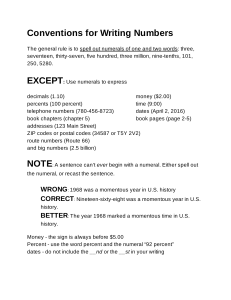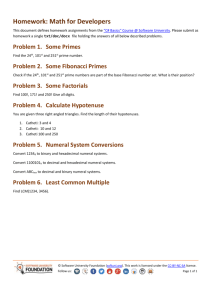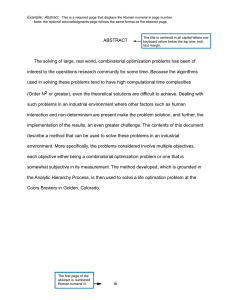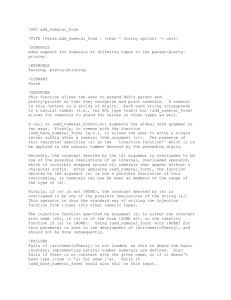C S OURSE
advertisement
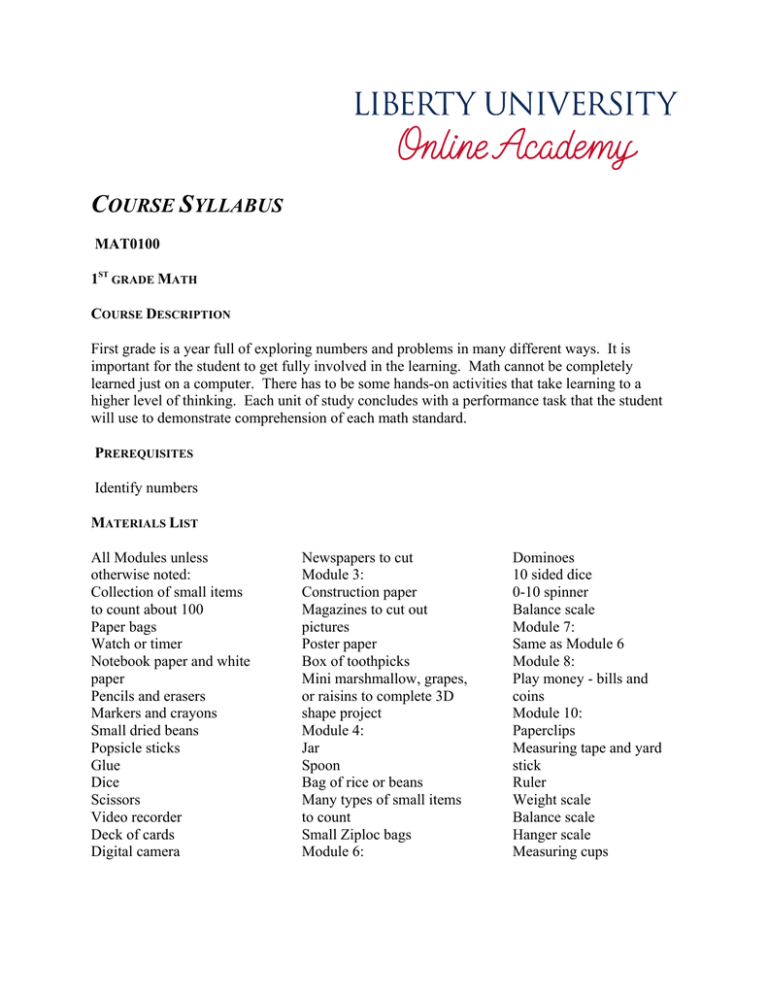
COURSE SYLLABUS MAT0100 1ST GRADE MATH COURSE DESCRIPTION First grade is a year full of exploring numbers and problems in many different ways. It is important for the student to get fully involved in the learning. Math cannot be completely learned just on a computer. There has to be some hands-on activities that take learning to a higher level of thinking. Each unit of study concludes with a performance task that the student will use to demonstrate comprehension of each math standard. PREREQUISITES Identify numbers MATERIALS LIST All Modules unless otherwise noted: Collection of small items to count about 100 Paper bags Watch or timer Notebook paper and white paper Pencils and erasers Markers and crayons Small dried beans Popsicle sticks Glue Dice Scissors Video recorder Deck of cards Digital camera Newspapers to cut Module 3: Construction paper Magazines to cut out pictures Poster paper Box of toothpicks Mini marshmallow, grapes, or raisins to complete 3D shape project Module 4: Jar Spoon Bag of rice or beans Many types of small items to count Small Ziploc bags Module 6: Dominoes 10 sided dice 0-10 spinner Balance scale Module 7: Same as Module 6 Module 8: Play money - bills and coins Module 10: Paperclips Measuring tape and yard stick Ruler Weight scale Balance scale Hanger scale Measuring cups MEASURABLE LEARNING OUTCOMES Module 1 The student will · count from 0 to 100 and write the corresponding numerals; and group a collection of up to 100 objects into tens and ones and write the corresponding numeral to develop an understanding of place value. · count forward by ones, twos, fives, and tens to 100 and backward by ones from 30. Module 2 The student will · count from 0 to 100 and write the corresponding numerals; and · group a collection of up to 100 objects into tens and ones and write the corresponding numeral to develop an understanding of place value. Module 3 The student will · identify the parts of a set and/or region that represent fractions for halves, thirds, and fourths and write the fractions. · identify and trace, describe, and sort plane geometric figures (triangle, square, rectangle, and circle) according to number of sides, vertices, and right angles. · construct, model, and describe objects in the environment as geometric shapes (triangle, rectangle, square, and circle) and explain the reasonableness of each choice. Module 4 · The student, given a familiar problem situation involving magnitude, will select a reasonable order of magnitude from three given quantities: a one-digit numeral, a two-digit numeral, and a three-digit numeral (e.g., 5, 50, 500); and · explain the reasonableness of the choice. · The student will sort and classify concrete objects according to one or more attributes, including color, size, shape, and thickness. · The student will recognize, describe, extend, and create a wide variety of growing and repeating patterns. Module 5 The student will · recall basic addition facts with sums to 18 or less and the corresponding subtraction facts. Module 6 The student will · demonstrate an understanding of equality through the use of the equal sign. Module 7 The student will · create and solve one-step story and picture problems using basic addition facts with sums of 18 or less and the corresponding subtraction facts. Module 8 The student will · identify the number of pennies equivalent to a nickel, a dime, and a quarter; and · determine the value of a collection of pennies, nickels, and dimes which has a total value of 100 cents or less. Module 9 The student will · tell time to the half-hour, using analog and digital clocks. · use calendar language appropriately (e.g., names of the months, today, yesterday, next week, last week). Module 10 The student will · use nonstandard units to measure length, weight/mass, and volume. · compare, using the concepts of more, less, and equivalent, a) the volumes of two given containers; and b) the weight/mass of two objects, using a balance scale. COURSE REQUIREMENTS AND ASSIGNMENTS A. Individual lesson assessments B. Education City assessments C. Weekly quizzes D. Projects COURSE GRADING AND POLICIES ALL ASSESSMENTS IN THE FIRST GRADE ARE GIVEN THE SAME WEIGHT. SCALE: A 93 – 100 B 85 – 92 C 77 – 84 D 70 – 76 F Below 70 OTHER POLICIES Academic Misconduct: See pages 27-30 of your Student Handbook Repeating Assignments: Students may have two attempts on lessons. Quizzes and tests cannot be repeated to gain a higher grade. Quizzes and tests may be reset for technical issues, but a new set of questions will be generated. Scope and Sequence Unit 1 - Number Sense Development Unit 2 – Place Value Unit 3 - Geometry Unit 4 - Estimation and Patterns Unit 5 - Addition and Subtraction Unit 6 - Fact Families and Equal Signs Unit 7 - Word Problems and 2-Digit Math Unit 8 - Money Unit 9 - Time Unit 10 - Measurement

